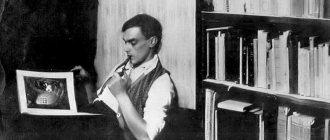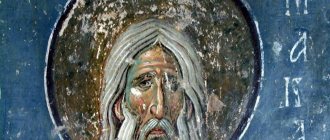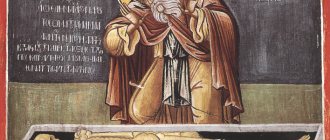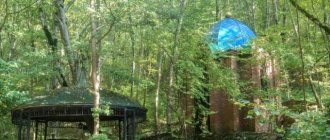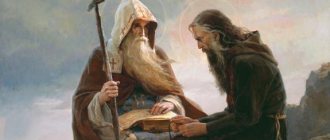| St. Theodosius Kinoviarch |
Theodosius the Great
(c. 424 - 529), cinenoviarch (founder of the monastic community), venerable Memory January 11
Born around 424 in the Cappadocian village of Mogariassus near the city of Comana from pious parents Proheresius and Eulogia. Having been a singer in the Coman church from a young age, the Monk Theodosius studied the Psalter and other books of Holy Scripture. The desire for solitude and desert life was noticeable in Feodosia even in his youth.
In his youth, he headed to Jerusalem and on the way received the blessing of Saint Simeon the Stylite. Having venerated the holy places of Jerusalem, Theodosius decided to settle in one of the desert monasteries.
Near Metope (now Umm Tuba), he found a monastery that was under the control of the disciples of Euthymius the Great and his companion Theoktistus, Marinus and Luke, and under their leadership he began to study the “canon of the desert.”
Soon he headed east, into the desert, and at the top of one of the mountain ridges he found a cave in which, according to legend, the gospel wise men spent the night on their way back from Bethlehem. Like Euthymius the Great and Savva the Sanctified, the Monk Theodosius did not immediately begin to build a monastery in the cave he had chosen; At first, through long-term solitude and strict asceticism, he prepared to lead others. The ascetics who settled around the cave found in Theodosius an already experienced leader; in difficult cases, he turned to the Bethlehem cinematographer Marcian. At the first stages of its existence, the monk of Theodosius stood in the same relation to the Lavra of Sava the Sanctified as the monk of Blessed Theoktistus and Saint Gerasim, that is, it prepared monks for the life of the Lavra. Then, having received the rank of archimandrite from Patriarch Sallust, the Monk Theodosius became a completely independent cinematographer of the entire desert.
The founders of new Palestinian monasteries usually took one of the previously existing monasteries as a model. There is no indication of such imitation in the life of Theodosius. The area he chose for the monastery differs sharply from the location of most Palestinian laurels: instead of stone deserts, we see here open mountainous hills with fertile soil. The ascetics of this kenobiya had to combine the contemplative life of the keliot with the hard work of the kenobite. They were concerned not only with personal improvement, like the Lavra keliots, but also with the spiritual success of their neighbors. The life of the Cenobites did not have the same character of isolation and strict solitude as in the laurels. When establishing his monastery, the Monk Theodosius, along with dwellings for the monks, erected buildings for the poor and needy, and these latter were for him the same concern as the brethren. The rumor about the generous charity of the monastery of Theodosius spread throughout Palestine, and many needy people flocked to it from everywhere. The philanthropy of the Kinovia reached particular development during the famine years; the rule of the monastic rule regarding the acceptance of all who come at such a time was observed here as strictly as at any other time. The cenovic form of life, which reached its final development in the monastery of Theodosius, attracted much more ascetics than Lavra Sava the Sanctified. The number of Cenobites reached 700, while the Great Lavra during its highest heyday (and centuries) numbered no more than 150 ascetics. The previously existing konovii gradually lost their importance and gave way to the konoviya of Theodosius. Her brethren included ascetics of the most diverse nationalities, as a result of which it was necessary to build four churches inside the monastery: for the Greeks, for the Georgians, for the Armenians and for the brothers of the Cenobians possessed by evil spirits.
With his condescending attitude toward the weaknesses of human nature, Saint Theodosius, according to Cyril of Scythopolis, resembled Saint John the Theologian.
During the reign of the Eastern Roman Emperor Anastasius, with his support, the Monophysite heresy again began to grow stronger, and the Orthodox began to suffer persecution. The Monk Theodosius firmly stood up for the defense of Orthodoxy and wrote a letter to the emperor on behalf of the hermits, where he denounced him and refuted all the heresies that had existed and were condemned by the Ecumenical Councils. He confirmed that the desert dwellers and monks would firmly adhere to the Orthodox confession. The emperor reconciled for a short time, and then resumed the persecution of the Orthodox. The holy elder then showed great zeal for the truth. He, leaving the monastery, came to Jerusalem and in the Great Church, standing on a dais, proclaimed publicly: “ Whoever does not honor the four Ecumenical Councils, let him be anathema.”
". For this brave act, the monk was exiled to prison, but soon, after the death of the emperor, he returned.
| St. Theodosius the Great. Mosaic from the monastery of Nea Moni, Greece (c.1050) |
The Monk Theodosius died on January 11, 529, at the age of 105 from birth.
The last three days before his death, he taught the brethren and the convened abbots of the monasteries subordinate to him with those words of love, meek condescension and admonition that they had repeatedly heard from him before. On the day of his burial, a huge crowd of monks and laity rushed to touch his body; many cut off pieces of his clothes in order to have something as a sign of memory of the deceased. The Life of Theodosius Kinoviarch is placed in “Acta Sanctorum” (January, vol. I), with a commentary, and in Usener’s editions: “Vita Theodosii a Cyrillo Scythopolitano scripta” (Bonn, 1890) and “Der heilige Theodosios” (Lpts., 1890) . The text of the lives published by Usener has been verified against five new manuscripts and provided with numerous additions and amendments by Krumbacher, in his “Studien zu den Legenden des hl. Theodosios" (“Sitzungsberichte der Akademie der Wissenschaften zu München”, 1892, tetr. II); These additions, however, are of more interest to the philologist than to the historian. Attached to this article is an akathist to St. borrowed from the Patmos Codex. Theodosius in Greek. Author of a commentary on the life of St. Theodosius in the Acta Sanctorum did not know to whom to attribute the composition of the life itself; pointing out Baronius's assumption that it was written by Cyril, he does not agree with this and considers the compiler of the life to be the student of Theodosius Julian, later bishop of Bostria. Usener's first published life from a century-old manuscript proved that the life of Theodosius included in the Acta Sanctorum belongs to Theodore, bishop. Petrsky, and presents a word of praise to the deceased ascetic on the day of his first annual commemoration (530). Cyril of Scythopolis knew this word and, in all likelihood, did not satisfy him with its rhetoric and prolixity; he compiled a new life of Theodosius, inferior in size to the previous one, but superior to it in the abundance of historically verified facts and precise chronological dates. Both lives were translated from Greek by prof. Pomyalovsky and compiled the 8th issue of the Palestinian patericon (1895).
Kontakion, tone 8
Planted in the courts of your Lord,/ you have flourished redly by your virtues like yours,/ and you have multiplied your children in the desert,/ soldered with clouds of your tears,/ the steward of God’s Divine herds. courtyards.// We also call: Rejoice, Father Theodosius.
THEODOSIUS I
THEODOSIUS I Flavius the Great (Flavius Theodosius Magnus) (346/347–395), rom. Emperor (from 379), canonized Catholic. Church. The last ruler of a united Rome. empires. Native of Northern Spain, F. I was the son of a prominent Roman. a military leader who fell into disgrace and was executed under the Emperor. Valentinians I. Made a brilliant military effort. career: successfully fought with the Sarmatians on the Danube, in 376 he received military service. command in the province Illyricum. In 379, after the heavy defeat suffered by the Romans from the Visigoths in the Battle of Adrianople, and the death of the emperor. Valens (378), became co-emperor. Gratian, having received the east under his jurisdiction. part of the empire. Having achieved supreme power, he proved himself to be a talented commander and a capable diplomat. Having won a number of victories in the war with the Visigoths, he entered into negotiations with them. In 382 he concluded a peace treaty, according to which the Visigoths were given the opportunity to settle as federates of the empire in Lower Moesia and Thrace. As a result of this and other decisions of F. I, the process of barbarization of Rome intensified. army. In the East, F. I managed to reach an agreement with the Sassanid power on the division of Armenia into spheres of influence (387). In the field of spiritual life, he carried out a number of decisive measures that radically changed religion. situation in Rome. empires. Issued the edict “On the Catholic Faith” in 380 in Thessalonica. In 381, the Second Ecumenical Council took place in Constantinople (see Ecumenical Councils), at which it was clarified and finalized. The Creed was formulated and the status of the Nicene religion as a state religion was established. religions Rome. empires. According to the decision of the council, episcopal sees could only be occupied by followers of the Nicene religion. Being under the spiritual influence of St. Ambrose of Milan, F. I not only persecuted heresies, primarily Arianism, but also consistently eradicated everything that was associated with paganism. In 381–385, persecution of pagans began: sacrifices were prohibited under pain of death, and pagan temples were ordered to be closed and destroyed. In 391, large fines were established for the worship of pagan gods; after 393, the Olympic Games ceased to be held. For religion In politics, Christian writers awarded F. I the epithet “great.” F. I had to suppress the revolts of the usurpers: in 388 - Magna Maxima, in 394 - Eugenius. From 394 he ruled alone over all of Rome. empire. Before his death, he divided the state between his sons: the eldest, Arkady, got the east. part with its capital in Constantinople (future Byzantium), the younger, Honorius, - zap. territories in 395–402 with the capital in Mediolana (modern Milan), from 402 in Ravenna.
Eodosius was born in northern Spain. His father, Honorius, was a commander in the army of Valens and descended from the Emperor Trajan. In his youth, Theodosius received a good general education, and learned military science in his father’s army. Under his command, he fought against the Scots and Saxons in Britain, and then against the Moors in Africa. His courage and abilities as a military leader were noted very early by the emperor. According to Marcellinus, Theodosius was appointed commander in Moesia at a time when he was still a beardless youth. In repeated skirmishes, he defeated the Sarmatian hordes and forced them to peace. But soon the fall and execution of Honorius seemed to put an end to the brilliant career of his son. Theodosius was stripped of all his posts and settled as a private citizen on his estate in Spain. However, his fall from grace was short-lived. In 378, the eastern emperor Valens was defeated by the Goths near Andrianople and died. Hordes of barbarians scattered throughout Thrace, captured Dacia, and reached the walls of Constantinople itself. In this extremity, the western emperor Gratian arrived in Sirmium, summoned Theodosius and on January 19, 379, proclaimed him Augustus and emperor over all the eastern provinces of the empire.
Theodosius took power at a very difficult time. According to the testimony of all writers, the Andrianople defeat plunged the Romans into complete despondency. The name of the Goths alone terrified the soldiers. There was no point in even thinking about fighting a new battle with such an army. Theodosius spent the next four years trying to restore the Romans' lost fighting spirit. The new emperor chose Thessalonica as his place of residence. From here he directed the fighting and governed his half of the empire. Military training soon brought results, and inertia and idleness were eradicated. Theodosius, generally distinguished by his sharp mind, valor and common sense, achieved firmness both by the severity of orders and by generosity and affection. And indeed, after the warriors gained faith in themselves, they began to attack the Goths more confidently and gradually drove them out of Thrace. But then Theodosius fell ill, and his condition was almost hopeless. This again gave the Goths insolence. Some of them went to plunder Thessaly, Epirus and Achaia, others rushed to Pannonia. When Emperor Gratian learned that, due to the fatal and hopeless illness of Theodosius, the Goths intensified their onslaught, he came to the east, gave them many gifts, supplied them with food and made peace with them. Meanwhile, Theodosius, broken by a serious illness, received baptism in 380 from the Orthodox Bishop Ascholia. His illness began to recede, and he was completely cured. Arriving after this in Constantinople, Theodosius showed himself to be an ardent defender of Orthodoxy. He suggested to the Arian bishop Demophilus either to accept faith in the consubstantiality of Christ with God the Father, or to leave the capital. Demophilus chose the latter. Following him, many Arians, who owned all the churches here for more than forty years, left Constantinople. In 381, Theodosius convened the Second Ecumenical Council in Constantinople, at which Arianism and other heresies were severely condemned, and the creed adopted at the Council of Nicea was clarified in such a way as to exclude any misinterpretation. The emperor, with his authority, approved this decision and issued a whole series of laws declaring the only correct faith of the fathers of the Council of Nicaea. All churches were henceforth to be transferred to the Orthodox clergy. In the same way, Theodosius, the first of the emperors, persecuted the pagans and issued a law ordering the closure and destruction of pagan temples throughout the empire. And in 394, Emperor Theodosius I, fighting against paganism, abolished the Olympic Games.
Meanwhile, the war with the barbarians gradually subsided. In October 382, Theodosius concluded an agreement with the leader Fritigern, according to which the Goths received land for settlement in Lower Moesia and Thrace and entered the service of the emperor as federates. From that time on, Theodosius ruled calmly and firmly until his death. Aurelius Victor writes that he was meek and kind to everyone, especially to good people. He gave elegant and cheerful feasts, but without pomp, his speech was respectable and pleasant. He was an affectionate father and an exemplary husband. As regards science, his education was mediocre, but he was naturally distinguished by insight. He was moderate in food and drink, and also distinguished himself by chastity and abstinence. However, he was angry and hot-tempered. In addition, they write that he was intemperate in spending and given to immoderate luxury, careless and even prone to laziness.
St. Ambrose does not allow Theodosius into the church. Anthony van Dyck (National Gallery in London, first third of the 17th century)
However, Theodosius was distracted from his measured and pleasant life by the strife in the western part of the empire. In 387 he stood up for Valentinian II, brother of Gratian, expelled from Italy by the tyrant Magnus Maximus. The rivals met in Pannonia on the banks of the Sava. The first day of the battle did not bring victory to anyone, but the next morning Theodosius, thanks to his superiority in the cavalry (it consisted entirely of barbarians - Goths and Alans), won the victory. Maxim was captured and executed. Theodosius spent the next three years in Italy, ruling the entire empire from here. Among the many useful deeds he performed at this time, historians write about one undoubtedly shameful one, which left a dark stain on the memory of this sovereign. In 390 there was a popular uprising in Thessalonica. Theodosius, without examining the matter, ordered the inhabitants of the city to be subjected to indiscriminate beatings. In total, about fifteen thousand townspeople were killed, regardless of gender or age. With this atrocity, Theodosius angered the Mediolan bishop Ambrose, who, in front of all the people, did not allow the emperor into the temple, since his hands were stained with the blood of innocents. To appease the prelate, Theodosius, dressed as a repentant sinner, publicly confessed his sins. He was the first of the emperors to defiantly bow his head before the authority of the church authorities.
That same year, Theodosius returned to Constantinople, leaving Valentinian in charge of the western part of the empire. Two years later, Valentinian was assassinated and the rhetorician Eugenius seized power. In 394, Theodosius marched against him at the head of his army. The battle took place near Aquileia on the banks of Frigis. On the first day, Eugene’s soldiers pushed back the barbarian detachments, of which there were a great many in the army of Theodosius. Only night saved Theodosius from complete defeat. But the next day he managed to lure a large detachment of the enemy to his side with promises. In addition, in the midst of the battle, a strong storm began. The wind blew straight into the faces of Eugene's soldiers. They could not withstand the double onslaught and fled. Eugene was captured and beheaded.
For a short time and for the last time, the entire empire was united in the hands of one sovereign. However, just four months later, Theodosius fell ill on the way from Rome in Milan and died, bequeathing power to his two sons.
Bicycle in Feodosia
The popular Crimean resort city of Feodosia is famous for its museums, restaurants and a huge variety of entertainment on the city embankment. Getting off the train and leaving the station building, city guests immediately find themselves in an atmosphere of celebration, fun and reckless relaxation. And this is great if you come to relax and have fun. But the local residents, the very ones who create all this resort splendor, are constantly in this “celebration of life”. Everyone needs a break: visitors, city residents, and sometimes city residents - from the ubiquitous visitors.
As you know, the best rest is a change of activity. Even if your job is casual and fun, you still need to rest. I think that the seller of cotton candy will not make cotton candy for himself on his day off. So let's change the type of activity, but let's do it in such a way that the vacation is not only fun, but also beneficial.
Good spirits, a cheerful mood, freedom of movement and undeniable health benefits - this is what we will focus on. And to accomplish all this, we will need a mountain bike in Feodosia . Of course! A bicycle gives you a feeling of freedom, fills your lungs with air and your heart with goodness, charges your entire body with vigor and takes you wherever you want.
And where is this “wherever you wish”? Are there any places in Feodosia where you can ride a bike and not meet crowds of peacefully strolling vacationers? Yes! There are such places, moreover, there are plenty of them.
If you wake up early and go for a ride at the beginning of eight in the morning, you can enjoy a walk along the deserted alleys and make a few laps in Komsomolsky Park. At such a time, you may only meet rare passers-by and cyclists like you.
But why limit yourself to the city limits, having an iron horse, with the spurs of which you can go, for example, to Quiet Bay near Koktebel. And you can go there in two ways, depending on the type of bike you have. For lovers of highway pegasuses, leaving the city along the Simferopol highway is perfect. Turning behind the village of Nasypnoye towards Podgorny, a small pass awaits you, after overcoming which you can enjoy a rapid descent. The main thing is not to miss the turn to the winery, and there is Cape Chameleon and Quiet Bay. If you prefer to travel by mountain bike, you can get to Tikhaya Bay along the roads along the sea. You leave the city along the street. Chelnokov, near Vinogradny you turn towards Ordzhonikidze and before entering the city go right onto the dirt road. Passing a coniferous grove, you move along the sea all the way to Quiet Bay. Here you definitely won’t encounter “crowds of vacationers”, since getting to these regions, even by car, is very problematic.
For those who already feel confident in the saddle, there are almost unlimited possibilities for riding in deserted places. If traveling a distance of 70-100 km is not something prohibitive for you, you can safely go on a weekend hike. To the north – through Valadislavovka to the Arabatskaya Strelka to the hot springs. To the east - past the fashionable hotels of Beregovoe, past Lake Ashchigol, past Primorskoye into the kingdom of endless dirt roads of the Kerch Peninsula. To the west - to Pervomaisky along the highway, behind it is Old Crimea, and there are mountains! Many magnificent mountain trails, tracts and plateaus.
We have decided on cycling routes. All that remains is a mere trifle - buy a bicycle in Feodosia . The modern solution is to buy online. This saves time, and of course money, because the price in online stores is often slightly lower than in regular stores. The online store ( www.velomir.com ) will help you select and purchase a bicycle. The convenience and ease of purchasing through the World Wide Web is undeniable. But nothing compares to the feeling you get when touching and looking at a bike in person.
A compromise that combines the advantages of online shopping and the opportunity to feel the bike with your own hands can be the purchase of a used bike. If you find an ad for sale online and make a purchase offline, you will save time and not get a “pig in a poke.” As in other cities, used bicycles are not uncommon in Feodosia. However, there are also often situations in which a bicycle purchased second-hand turns out to be stolen or its actual technical condition does not correspond to the seller’s descriptions. But how to protect yourself from unpleasant surprises and disappointments? If you are interested in inexpensive bicycles in Feodosia , then you can choose a suitable budget bicycle in a specialized store.
As in any major tourist center, the service sector and public catering are very well developed in Feodosia. You can easily buy all kinds of souvenirs and gifts, and then have a delicious dinner in a cafe or restaurant. But a new direction in trade is the sale of bicycles in Feodosia . Indeed, this area is not as in demand as the sale of beach umbrellas, swimming goggles and reproductions of paintings by Aivazovsky. But a bike shop in Feodosia . If you look inside, you will get a lot of positive emotions. Works of technical art – there’s no other way to describe the bicycles made in the workshops of the Merida and Giant . World leaders - that says it all. You just have to want it, and the walk home will no longer be on foot.
I think it wouldn’t hurt to visit a bike shop with your child. Buying a children's bicycle in Feodosia means giving a tangible piece of happiness to a young cyclist. When purchasing a children's bicycle from brands such as Trek, Pride or Giant, you receive a 100% guarantee of quality, and as a result, reliability and safety during operation. If your child is interested in sports, and you often hear the words: parkour, freestyle, hip-hop from his lips, then the phrase “I bought you a BMX” will bring him into indescribable delight. choose a decent BMX from two well-known manufacturers: Giant and Premium.
So, you have everything for an active holiday: a new bike, mountain and highway roads, fresh sea air and of course the city itself. Theodosia translated from ancient Greek means “given by God.” Don't forget that living, working and relaxing in such a beautiful city is simply wonderful! Free yourself from everyday worries, get the most out of your holiday, ride a bike with pleasure, smile more often and be healthy, with the VELOMIR store.
What do they pray to St. Theodosius for?
When praying to Saint Theodosius, believers can supplement the canonical texts of prayers with their own words. The main thing is that these words be spoken with a pure heart and sincere faith that prayer will reach the throne of God:
- they ask the Saint for healing from serious illnesses;
- they turn to Theodosius the Great, asking for strengthening in faith;
- the spouses ask Theodosius the Great to grant them wisdom and mutual understanding;
- They pray to the saint for the salvation of poor and homeless people.
When turning to the Saint, believers usually read the following prayer:
O venerable and God-bearing Father Theodosius! You, desiring to serve the Lord, labored tirelessly in labor, in vigils, in prayers and fasting, and you were a mentor to monastics, and a loving father to all people. Now, after your departure from the earthly, standing before the Heavenly King, pray to His goodness to show mercy to the place of your settlement, your holy abode, where you abid in the spirit of your love, and to all who come to you with faith to fulfill their good requests. Ask our Merciful Lord to grant us an abundance of earthly blessings, even more so for the benefit of our souls, and may He grant us the end of this temporary life in repentance, and on the Day of Judgment may He merit us to stand and enjoy His Kingdom forever centuries. Amen.
Russian spiritual mission in Jerusalem
In the Judean mountains, 11 km east of Bethlehem, the monastery of St. Theodosius, which has existed since the end of the 5th century, has grown around the “cave of the Magi”. The founder of the monastery, the Monk Theodosius the Great, was at one time made the head of all cenobitic monasteries in Palestine, of which there were many at that time. A friend and co-faster of the Monk Sava the Sanctified, Theodosius the Great was born around 424 in Cappadocia from pious parents. From his youth, working as a reader and singer in church, he fervently prayed that the Lord would guide him on the path of salvation. And so, by the will of God, in 451 he went to Jerusalem. In Antioch, Theodosius received the blessing of the perspicacious Simeon the Stylite, who predicted that in the future he would become a great ascetic. In Jerusalem, he studied monastic labors with the elder Venerable Longinus the Stylite, who a few years later blessed his great disciple to settle at the newly created temple, halfway from Jerusalem to Bethlehem. Soon many learned about the virtues of the new ascetic of God, and people began to flock to him in search of spiritual instructions. Glory weighed heavily on the Monk Theodosius, and it was then that he retired to a cave where, according to legend, three wise men spent the night on their way to Bethlehem with gifts. He lived in the desert for more than thirty years, spending time in prayer and fasting: he did not eat bread at all, he ate only dates, roots and herbs growing around him.
His feat became known, and the monk had disciples. At first there were seven of them. When the cave could no longer accommodate the gathered monks, the mentor began to pray that the Lord Himself would indicate the place for the monastery. Taking with him a censer with cold coals, Theodosius walked through the desert. In one place, the coals suddenly flared up and incense burned. Here the monk founded the first communal monastery, or Lavra, according to the charter of St. Basil the Great. Soon this Lavra became famous, and up to 700 monks gathered in it. Many of them later became the founders of other monasteries and became famous for their monastic exploits.
Not only monks, but also laypeople - wanderers, beggars, the sick and the poor - found peace of mind in the Theodosian Lavra. The Lord miraculously, through the prayers of St. Theodosius, multiplied the supplies so that there was enough for both the brethren and the many wanderers who found food in the Lavra during the famine. Several hospice houses and hospitals were set up in the monastery. Through the efforts of St. Theodosius, churches were created for the brethren of different nationalities - Greeks, Georgians and Armenians, in which services were performed in their native language.
During the reign of the Constantinople emperor Anastasius (491–518), the heresy of Eutyches and Severus arose, which did not recognize either the sacraments or the priesthood. The emperor joined the false teaching. Trying to win Saint Theodosius over to his side, Anastasius sent a lot of gold as a gift to the Lavra. The Monk Theodosius firmly stood up for the defense of Orthodoxy and wrote a letter to the emperor on behalf of the hermits, where he denounced him and refuted all the heresies that were former and condemned by the Ecumenical Councils. He confirmed that the desert dwellers and monks would firmly adhere to the Orthodox confession. For a short time, the emperor reconciled, but then resumed the persecution of the Orthodox. Then the holy elder Theodosius, leaving the monastery, came to Jerusalem and in the Great Church, standing on a dais, proclaimed publicly: “Whoever does not honor the four Ecumenical Councils, let him be anathema.” For this the monk was exiled to prison, but soon returned after the death of the emperor. During his lifetime, Saint Theodosius was granted the gift of many miracles from the Lord. He died at the age of 105, in 529. The saint's body was buried with honor in the cave in which he lived at the beginning of his feat.
In the same cave, some holy wives found their rest, including Saint Sophia, the mother of Saint Sava the Sanctified. In 1173, the Russian princess St. Euphrosyne of Polotsk was buried here.
Last days of life
After his release from prison, the righteous man returned to his former life within the walls of his native monastery and performed many miracles there. Through his prayers, people lost in the desert were saved, wounded warriors recovered, and shipwreck victims survived.
The monk predicted the news of an impending earthquake in Antioch several days in advance, and called on the monks to pray for the salvation of the inhabitants of this city. Theodosius the Great lived to a ripe old age and died at the age of 105. The Primate of the Orthodox Church was buried in the cave where he began his ascetic journey.
Tomb of St. Theodosius the Great
The childhood and youth of St. Theodosius
The future righteous man was born in the 5th century into a family of Christian believers; it is not possible to determine more accurate information about the birth and family of St. Theodosius. It is known that the monk was born in Cappadocia.
Venerable Theodosius the Great
Since childhood, the boy had a craving for church services and loved to attend services. He had a beautiful, sonorous voice, so from childhood he sang in the church choir: this activity was one of the favorite activities of the future ascetic.
Already in his childhood and adolescence, Theodosius was sharply different from his peers: he was a very smart guy and could achieve success in any industry, but the boy saw his real calling only in serving God. When he once managed to meet with Simeon the Stylite, he predicted the guy a glorious future as an ascetic of Christianity.
The hermit’s words sank deeply into Theodosius’s soul, but he was not entirely sure that he was worthy of such a great honor - to serve the Lord faithfully and truly and to make this activity his life’s work. On the other hand, the guy did not see himself in any other role and did not want a different fate for himself.
Founding of the first Christian Lavra
The saint did not interfere with the monks if they wanted to settle in his cave and live under his leadership. Soon the modest dwelling of the righteous man could no longer accommodate everyone, and then the decision was made to create the first monastic community.
Before starting the construction of the new monastery, Saint Theodosius turned to the Lord with a request to indicate the best place for the future monastery. After this, the Saint took the censer in his hands and walked through the desert. After some time, the cold coals flared up. It was on this site that a monastery was subsequently founded, in which more than 700 monks lived permanently.
Icon of Theodosius the Great, Kinoviarch
Saint Theodosius was distinguished by immeasurable kindness, which was confirmed in the deeds of mercy performed by the righteous man. At one time there was a very severe famine in Palestine, and people went to the monastery asking for food and protection. The Monk Theodosius ordered the gates to be opened and all those suffering to be admitted.
The monks were worried that there would be nothing to feed the people and that the walls of the monastery would not be able to accommodate so many people. However, when the monks entered the refectory, they saw that it was filled to the brim with bread, which, through the prayers of the abbot of the monastery, the Lord had given to the suffering.
Interesting! Such miracles were repeated every time the Monk Theodosius wanted to provide help to those who needed it. The gates of the monastery were always open to all poor, sick and hungry people.
Soon, separate hospitals for the laity, refectories for the poor and homes for the elderly were built on the territory of the monastery. People of different nationalities came to the monastery, so the abbot of the community ordered that services be conducted in several languages at once: Greek, Armenian and Georgian.
